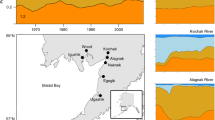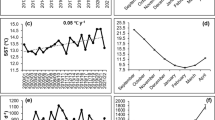Abstract
Knowledge of the effect of environmental variables on the early life history of fishes is essential to assess the effect of future environmental changes on the recruitment of commercial species. We investigate the effect of sea warming on two small pelagic fishes (Engraulis encrasicolus and Sardinella aurita) in the NW Mediterranean Sea based on the analysis of ichthyoplankton data collected in two surveys of contrasting conditions: the exceptionally warm summer of 2003, which may be indicative of conditions under future climate change scenarios, and the summer of 2004, with temperatures within the climatic average for the period 2000-2012. We use fine-resolution environmental variables measured locally and Generalized Additive Models to assess the influence of environment on these two summer-spawning small pelagic fishes. We show that sea surface temperature is the main environmental factor explaining abundance, but other factors (food availability and water currents) have additional roles tuning the effect of temperature. In the hot summer of 2003 we observed a decline of local egg production of anchovy and an increase of larval advection from the colder Gulf of Lions compared to 2004. Round sardinella spawning was higher in 2003 than in 2004 and extended over a wider area, but larvae viability was compromised by the lower availability of trophic resources. We hypothesize that future changes in environmental forcing on these two co-occurring summer spawning species will determine differential larval survival, with cascading effects on the upper trophic levels which feed on these species, including negative impacts on their fisheries.



Similar content being viewed by others
References
Acker JG, Leptoukh G (2007) Online analysis enhances use of NASA earth science data. EOS Trans Am Geophys Union 88(2):14–17
Albouy C et al (2012) Combining projected changes in species richness and composition reveals climate change impacts on coastal Mediterranean fish assemblages. Glob Change Biol 18:2995–3003
Alheit J, Bakun A (2010) Population synchronies within and between ocean basins: apparent tele connections and implications as to physical-biological linkage mechanisms. J Mar Syst 79:267–285
Bacheler NM et al (2012) Do walleye pollock exhibit flexibility in where or when they spawn based on variability in water temperature? Deep Sea Res (Part II) 65–70:208–216
Beaugrand G et al (2003) Plankton effect on cod recruitment in the North Sea. Nature 426:661–664
Ben-Tuvia A (1960) Synopsis of biological data on Sardinella aurita of the Mediterranean sea and other waters. FAO Fish Biol Synopsis 14:287–312
Brander KM (2010) Cod Gadus morhua and climate change: processes, productivity and prediction. J Fish Biol 77(8):1899–1911
Brander KM (2013) Climate and current anthropogenic impacts on fisheries. Clim Chang 119(1):9–21
Brochier T et al (2013) Climate change scenarios experiments predict a future reduction in small pelagic fish recruitment in the Humboldt current system. Glob Change Biol 19:1841–1853
Burnham KP, Anderson DR (2002) Model selection and multimodel inference. Springer, New York
Calvo E et al (2011) Effects of climate change on Mediterranean marine ecosystems: the case of the Catalan Sea. Clim Res 50:1–29
Castellón A et al (1990) The liguro-provençal-catalan current (NW Mediterranean) observed by doppler profiling in the Balearic sea. Sci Mar 54:269–276
Cheung WW et al (2013) Signature of ocean warming in global fisheries catch. Nature 497:365–369
CIESM (2008) Climate Warming and Related Changes in Mediterranean Marine Biota. CIESM Workshop Monographs, 35. Monaco. 152 pp.
Conversi A et al (2010) The Mediterranean sea regime shift at the end of the 1980s, and intriguing parallelisms with other European basins. PLoS One 5:10633
R Development Core Team (2011). R: A language and environment for statistical computing. R Foundation for Statistical Computing, Vienna, Austria. ISBN 3-900051-07-0, URL http://www.R-project.org/.
Durrieu de Madron X et al (2011) Marine ecosystems’ responses to climatic and anthropogenic forcings in the Mediterranean. Prog Oceanogr 91:97–166
Edwards M, Richardson AJ (2004) Impact of climate change on marine pelagic phenology and trophic mismatch. Nature 430:881–884
Estrada M, Salat J (1989) Phytoplankton assemblages of deep and surface water layers in a Mediterranean frontal zone. Sci Mar 53:203–214
Estrada M et al (1993) Variability of the deep chlorophyll maximum characteristics in the Northwestern Mediterranean. Mar Ecol Prog Ser 92:289–300
Font J et al. (1988) Permanent features of the circulation in the Catalan sea. In: Minas HJ, Nival P (eds) Pelagic Mediterranean oceanography. Oceanol Acta 9: 51–57.
França S, Vasconcelos RP, Fonseca VF, Tanner SE, Reis-Santos P, Costa M, Cabral HN (2012) Predicting fish community properties within estuaries: influence of habitat type and other environmental features. Estuar Coast Shelf Sci 107:22–31
Giannoulaki M et al (2013) Characterizing the potential habitat of European anchovy Engraulis encrasicolus in the Mediterranean sea, at different life stages. Fish Oceanog 22(2):68–89
Hastie TJ, Tibshirani RJ (1990) Generalized additive models. Chapman and Hall, New York
Hidaka K (1940) Absolute evaluation of oceanic currents in dynamic calculations. Proc Imp Acad (Tokyo) 16:391–393
Houde ED (1997) Patterns and trends in larval-stage growth and mortality in teleost fish. J Fish Biol 51:52–83
Houde ED (2008) Emerging from Hjort’s shadow. J Northw Atl Fish Sci 41:53–70
Hsieh C et al (2005) A comparison of long-term trends and variability in populations of larvae of exploited and unexploited fishes in the Southern California region: a community approach. Prog Oceanogr 67:160–185
Lleonart J, Maynou F (2003) Fish stock assessments in the Mediterranean: state of the art. Sci Mar 67(1):37–49
Martín P et al (2012) Climate modulation of fish populations: the role of the western Mediterranean oscillation (WeMO) in sardine (Sardina pilchardus) and anchovy (Engraulis encrasicolus) production in the north-western Mediterranean. Clim Change 110:925–939
Molinero JC et al (2008) Climate control on the long-term anomalous changes of zooplankton communities in the Northwestern Mediterranean. Glob Change Biol 14:11–26
Morote E et al (2008) Diet of round sardinella, Sardinella aurita, larvae in relation to plankton availability in the NW Mediterranean. J Plankton Res 30:807–816
Morote E et al (2010) A comparison of anchovy (Engraulis encrasicolus) and sardine (Sardina pilchardus) larvae feeding in the Northwest Mediterranean: influence of prey availability and ontogeny. ICES J Mar Sci 67:897–908
Palomera I et al (2007) Small pelagic fish in the NW Mediterranean sea: an ecological review. Prog Oceanog 74:377–396
Peck MA et al (2012) Intrinsic and extrinsic factors driving match-mismatch dynamics during the early life history of marine fishes. Adv Ecol Res 47:177–302
Pörtner HO (2002) Climate change and temperature dependent biogeography: systemic to molecular hierarchies of thermal tolerance in animals. Comp Biochem Physiol A 132:739–761
Pörtner HO, Peck MA (2010) Climate effects on fishes and fisheries: towards a cause-and-effect understanding. J Fish Biol 77(8):1745–1779
Rijnsdorp AD et al (2009) Resolving the effect of climate change on fish populations. ICES J Mar Sci 66:1570–1583
Rubio A et al (2005) A field study of the behaviour of an anticyclonic eddy on the Catalan continental shelf (NW Mediterranean). Prog Oceanog 66:142–156
Sabatés A et al (2006) Sea warming and fish distribution: the case of the small pelagic fish, Sardinella aurita, in the western Mediterranean. Glob Change Biol 12:2209–2219
Sabatés A et al (2007) Advection of anchovy (Engraulis encrasicolus) larvae along the Catalan continental slope (NW Mediterranean). Fish Oceanog 16:130–141
Sabatés A et al (2008) Vertical distribution of early developmental stages in two coexisting clupeoid species, Sardinella aurita and Engraulis encrasicolus. Mar Ecol Prog Ser 364:169–180
Sabatés A et al (2009) Spawning environmental conditions of Sardinella aurita at the northern limit of its distribution range, the western Mediterranean. Mar Ecol Prog Ser 385:227–236
Sabatés A et al (2010) Planktonic cnidarians distribution and feeding of Pelagia noctiluca in the NW Mediterranean. Hydrobiol 645:153–165
Sabatés A et al (2013) Role of mesoscale eddies in shaping the spatial distribution of the coexisting Engraulis encrasicolus and Sardinella aurita larvae in the northwestern Mediterranean. J Mar Syst 111–112:108–119
Salat J (1996) Review of hydrographic environmental factors that may influence anchovy habitats in northwestern Mediterranean. Sci Mar 60(2):21–32
Salat J et al (2002) Seasonal changes of water mass structure and shelf slope exchanges at the Ebro shelf (NW Mediterranean). Cont Shelf Res 22:327–346
Schär C et al (2004) The role of increasing temperature variability in European summer heat waves. Nature 427:332–336
Smith P, Richardson S (1977) Standard techniques for pelagic fish egg and larva surveys, FAO Fish Tech Pap 175. Food and Agriculture Organization of the United Nations, Rome
Somarakis S et al (2002) Distribution and abundance of larval fish in the northern Aegean sea – eastern Mediterranean – in relation to early summer oceanographic conditions. J Plankton Res 24:339–357
Somarakis S et al (2011) Contrasting multispecies patterns in larval fish production trace inter-annual variability in oceanographic conditions over the N.E. Aegean sea continental shelf (Eastern Mediterranean). Hydrobiol 670:275–287
Somarakis S et al (2012) High variability in the daily egg production method parameters of an eastern Mediterranean anchovy stock: influence of environmental factors, fish condition and population density. Fish Res 117–118:12–21
Stenseth NC et al (2002) Ecological effects of climate fluctuations. Science 297:1292–1296
Stewart RH (2008) Introduction to Physical Oceanography. http://oceanworld.tamu.edu/resources/ocng_textbook/contents.html
Takasuka A (2008) Multi-species regime shifts reflected in spawning temperature optima of small pelagic fish in the western North Pacific. Mar Ecol Prog Ser 360:211–217
Tsikliras AC (2008) Climate-related geographic shift and sudden population increase of a small pelagic fish (Sardinella aurita) in the eastern Mediterranean sea. Mar Biol Res 4:477–481
Vargas-Yáñez M et al (2010) Climate change in the western Mediterranean sea 1900–2008. J Mar Syst 82:171–176
Wasserman L (2005) All of nonparametric statistics, chapter 2. Springer, New York
Wintle BA et al (2005) Fauna habitat modelling and mapping: a review and case study in the lower hunter central coast region of NSW. Australian Ecologist 30:719–738
Wood S (2006) Generalized additive models: an introduction with R. CRC/Taylor and Francis.
Acknowledgments
This work was partially supported by the EU Project VECTORS (FP7 OCEAN-2010, 266445) and by the Spanish project FISHJELLY (MAR-CTM2010-18874). Analyses and visualizations used in this paper were produced with the Giovanni online data system, developed and maintained by the NASA GES DISC. We acknowledge the comments of three anonymous reviewers that helped improve the final version of the manuscript.
Author information
Authors and Affiliations
Corresponding author
Rights and permissions
About this article
Cite this article
Maynou, F., Sabatés, A. & Salat, J. Clues from the recent past to assess recruitment of Mediterranean small pelagic fishes under sea warming scenarios. Climatic Change 126, 175–188 (2014). https://doi.org/10.1007/s10584-014-1194-0
Received:
Accepted:
Published:
Issue Date:
DOI: https://doi.org/10.1007/s10584-014-1194-0




